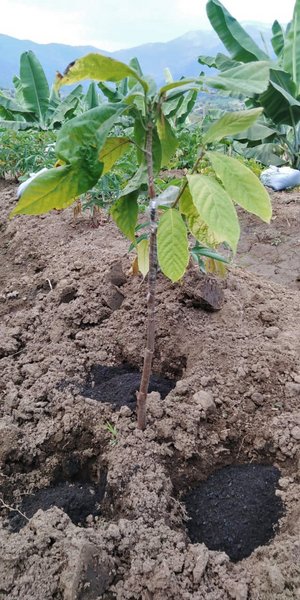Cadmium in Peruvian cacao: framing the problem and investigating solutions

Our researchers are working to understand mitigation of the toxic element cadmium in Latin American cacao.
Last year, a European Union Regulation (488/2014) went into effect specifying the acceptable level of cadmium in chocolate and cacao-based products throughout Europe. Because the policy was first announced in 2014, producers had a five-year period to carry out cadmium mitigation activities; this was particularly relevant in Latin America where levels of cadmium in cacao beans are reportedly higher than in other cacao-producing areas.
Many countries in Latin America are important exporters of native fine and flavor cacao to high-end European markets. More significantly, cacao in these countries is often produced by small-scale farmers who are economically vulnerable to changes in the international market. Last year, Bioversity International (now the Alliance of Bioversity International and CIAT) conducted a survey with 200 households in northern Peru and found that 60% of farmers have experienced a loss in income since the regulations came into effect.

Scientific investigation to understand the extent of the problem and reduce cadmium accumulation into cacao beans - therefore alleviating the economic burden for small-scale farmers - has been underway in Peru for several years. In 2017, the Peruvian Government provided funds to investigate the extent of cadmium accumulation in cacao across the country. These funds also set out to identify low cadmium-accumulating genotypes and test soil amendments that could reduce the uptake of cadmium from soils. The project was led by Bioversity International in collaboration with the Ministry of Agriculture (SENASA and INIA) as well as the National University of Piura and the Agrarian University La Molina, the Cooperativa Agraria NorAndino and the private sector. The project was undertaken at an unprecedented scale, with the collection of soil, bean, leaf and root samples from 1,900 cacao trees across the country, and the installation of two field trials in the north of Peru.
Six additional trials were installed in the central Amazonian region with funding from USAID, through the USDA Cacao Seguro initiative, in collaboration with Alianza Cacao Perú, while further three trials were set up in the north of the country in collaboration with APPCACAO, NorAndino and Original Beans, with financial support from the international cooperation, cacao companies and the private sector. Funding from the Peru/Ecuador Binational Fund for Peace & Development enabled cadmium sampling in four watersheds in the Amazonas department. This helped to address local concerns in an area where cacao cultivation has been promoted to stabilize the livelihoods of indigenous border communities.
One of the most important findings so far is that high cadmium concentrations in cacao beans are not present in all of Peru, but instead are focused in only a few areas. From the over 1,000 bean samples analysed, high concentrations of cadmium appear to be mainly restricted to the northern regions and some central areas of the country. The south of the country is not affected. This includes cacao from the department of Cusco, which is known for cacao chuncho - a popular native fine flavour variety.
However, the pattern of accumulation is not so straightforward. While cacao trees growing in soils with higher levels of cadmium tend to have higher concentrations of cadmium in their beans, there is a lot of variability. This means that even in the northern areas where cadmium is generally high in beans, there are valleys, farms and trees that have low levels of cadmium. This illustrates the complex interactions between geology, soil, site management and genotype on how cadmium accumulates in individual trees.

The ten field trials are key to understanding this interaction, and in helping find solutions for farmers in areas with high levels of bean cadmium. Different soil amendments are being trialed, including biochar, fertilizer, microbiological soil enhancements, micronutrients, silica from diatomaceous earth, organic matter, and lime. As these are long term trials, samples continue to be collected and analyzed and with the 2020 cacao harvest currently underway, more data will soon be available. So far, promising results in field trials in the north have been seen with the addition of a biochar-based product, with initial results showing a 40-80% reduction in the cadmium concentration in cacao beans. The next round of analyses will illuminate if these findings continue in the long term. Additionally, the genetic basis of low cadmium accumulation is being studied, aiming to identify genotypes that could be used as root stock or grafting material to replace high cadmium accumulating materials.

The search for practical and low-cost mitigation solutions is ongoing, and as the past two years of collaboration illustrate, the key is to work together. Furthermore, a new Alliance-led project, Clima-LoCA, funded by the European Commission Initiative “Development-Smart Innovation through Research in Agriculture” (DeSIRA), will allow this work to continue and provide increased coordination between research in Peru, Ecuador, and Colombia. More details on up-to-date findings and current projects on the mitigation of cadmium absorption in cacao beans across Latin America can be found in a Bioversity International publication funded by the Development Bank of Latin America.
All actors across the value-chain can help in their own way to support smallholder farmers, and we hope that the multidisciplinary, multi-institutional efforts we are working on will enable robust solutions to be reached.
Partners and collaborators:
Ministry of Agriculture & Irrigation, Peru; the National Institute of Agricultural Innovation (INIA) the National Service of Agricultural Health (SENASA); The University of Piura, the National Agrarian University of La Molina; the Agrarian Cooperative Norandino; USAID through the USDA Cacao Seguro Initiative; APPCACAO; Swiss Intercooperation; SeCompetitivo; Equal Exchange; CDF Canada; Original Beans; IDH; Peru-Ecuador Binational Fund for Peace & Development;
COMACSA; Inkan Negro; Fertilev; Feys; Yara; National University of San Marcos; Scientific University of the South and national research grants; Development Bank of Latin America CAF.


